And...no....this individual hasn't fallen in the way you might imagine.
This Brute wasn't felled by a bullet or an arrow (he was far too smart to be outwitted by the average hunter).
It was the mechanical beast.....that metallic slayer......death on wheels.....which brought this Titan down.
A student forwarded these pictures to me a few days ago. They were taken in a cornfield along a roadside not far from where we had obtained photos and video clips of large bucks just a few weeks ago.
Photo by B. Chapman
Photo by B. Chapman
Photo by B. Chapman
Comparing pics of the roadkilled specimen above to the individual below, would suggest to me they are one and the same.
A fairly sad state of affairs, if you ask me.
This impressive individual was removed from the breeding population at (what would appear to be) the prime of his life.
Although....it's not all gloom and doom, I suppose. As far as I can tell, the big fella below is still wandering around out there somewhere (he was also the star of a recent blog post here). We'll see if he lasts the hunting season.
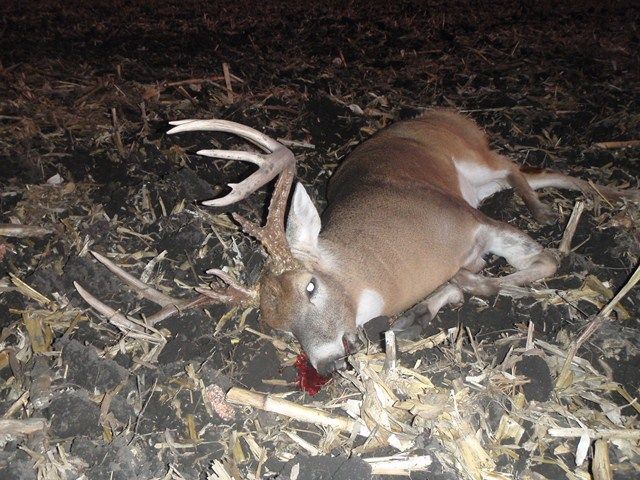
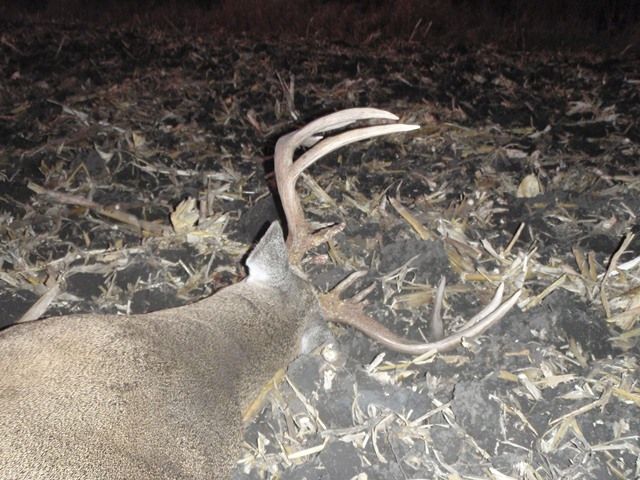
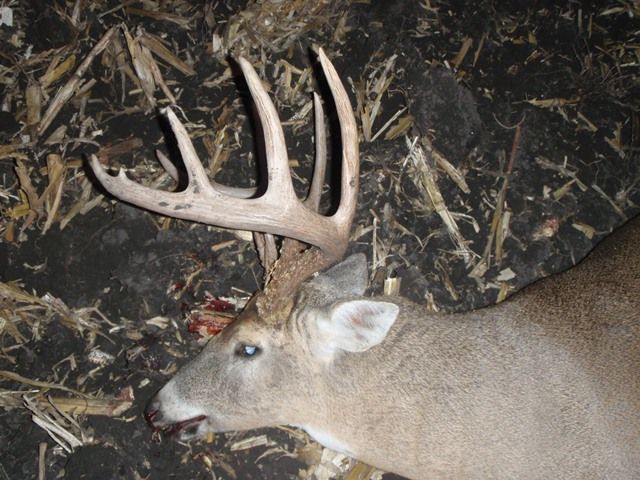
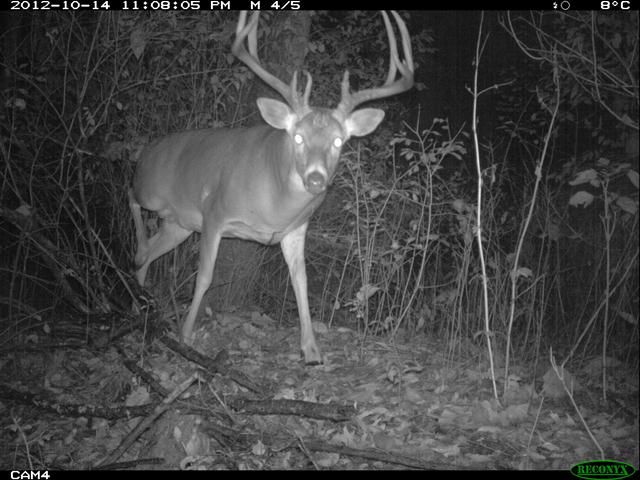
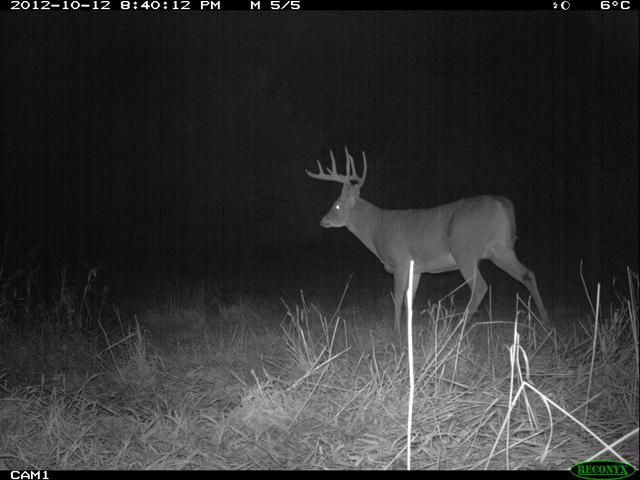

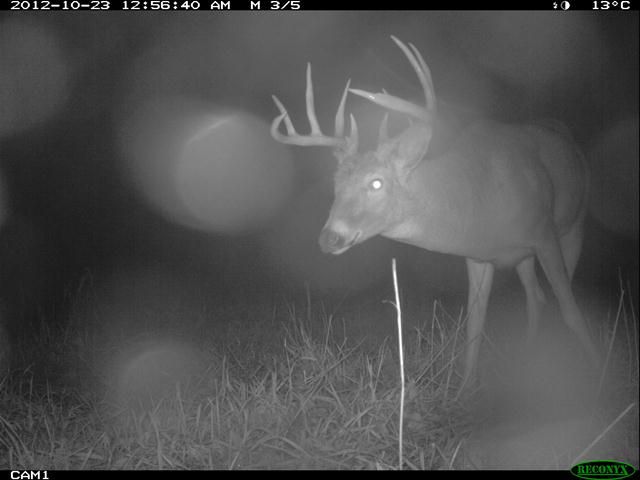
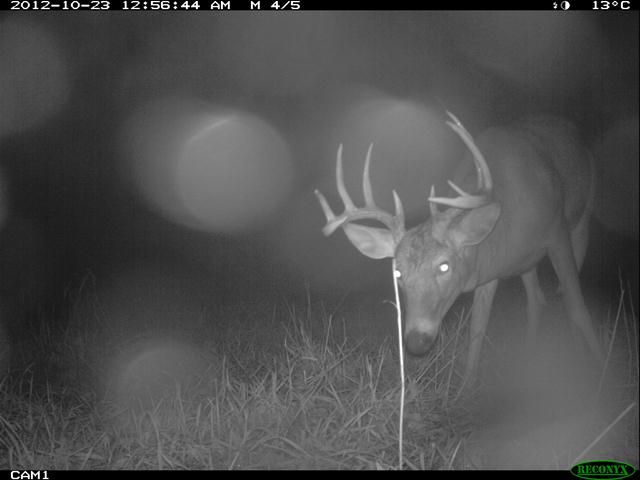
Hopefully those big boys have bred by now. I spent two hours this evening watching three black-tail bucks joust and track the does on the hillside below my house in coastal California. Shocking they do this in public! My hunting co-worker says the rut is over in his area the next mountain range over but they sure seem to have cycled back into rut again here. So it is still important to slow down on the local roads or there goes your rack.
ReplyDeleteHi Cindy! I imagine this fella had alread bred this year (although I've seen breeding behavior in deer 'round here all the way into Feb...see pics at this post..
ReplyDeletehttp://blazin-trailblazer.blogspot.com/2012/02/bloody-concession-vs-dogged.html
...the main part of the rut *should* be done). He's probably passed on his genes, assuming his Does made it through the hunting season.
Still....sort of seems like a shame that this individual, in his prime, is removed from the breeding population for future years. Mostly because his removal was due to a type of selective pressure that his species didn't naturally face for the first several million years of their evolution (according to Giest's "Deer of the World", Odocoileus virginianus evolved around 3.5 million years ago during the Pliocene).
Not that there isn't plenty of deer 'round here....but still....
Thanks for the comment! I can't believe you saw some sparring during the day in public. Very cool!
I'm trying to figure out any analogies between large predators like wolves and automobiles. I don't think autos are selective.
ReplyDeleteGreat point! Absolutely not!
ReplyDeleteI also occassionally hear the argument that human hunters can be a proxy for natural predation....but I don't buy that either. Although human hunters are selective (unlike cars), they often look for the "trophy" animals....and wolves are not likely to go after the largest, baddest buck in the herd (much more risky to take down). Then there's the fact that the hunting seasons are during a very specific time of year...every year, and not occurring throughout the year and so on.....
I hope someone harvested the antlers so that his legacy can be remembered! What a gorgeous deer.
ReplyDeleteI was looking through my photos of the jousting black-tails again tonight and that reminded me that I watched and photographed a buck head-butting a doe. I have never seen that before. That seems odd.
ReplyDeleteInteresting.... Was he head-butting her head on, or from the side/back (like he was trying to get her to stand)?
DeleteThe buck was hitting the doe forehead to forehead and he even pushed her back a few steps. I'll try to post some photos this weekend. It was a group of several bucks among does and their young. I checked with binocs and then later enlarged the photos and no signs of antlers or pedicels and the doe looked at least several years old by size.
ReplyDeleteNice coverage Trailblazer. Surprisingly, big bad bucks like this can get hit pretty hard by the apex predators, such as lions and wolves, during/around rut. How? - because they often travel alone, and their brains are so addled by chemistry they lose caution and alertness. Kinda like a drunk guy that stupidly tries to stagger home down dark alleys every night. It only takes one bad turn.
ReplyDeleteI was cam trapping a lion here in the SC Mtns during rut 2 years ago, and the lion picked off the 3 biggest bucks that came through, one right after each other. It was amazing.
Bucks head-butting does... could be coercion (get moving) or playfulness. I've seen does head-butt each other playfully. I've seen does and fawns playfully head-butt turkeys and jackrabbits too. And the turkeys and jacks playfight back.
Random, I read SC as meaning "South Carolina" at first and was about to send an entirely different reply :)
DeleteGood point, RT!
ReplyDeleteI should have clarified in my response that I was referring to how fit the individual male was when I said “baddest buck in the herd” (a less-than technical description, to be sure) :).
Mech and Peterson (in their chapter in Mech and Boitani's book on Wolf ecology) outline what constitutes vulnerability of prey to apex predators. They mention that bucks during the rut are particularly susceptible.
They also review the assertion that less-fit individuals are generally more susceptible to predation by top carnivores....with a fair amount of data to support the claim. Of course, having lower fitness can take many forms (age, health, etc.). While bad-a$$ bucks are not necessarily less fit, they may be more vulnerable (pre-occupied or in poor condition due to the rut) and may fall victim because of this. Yet, Mech and Peterson also cite examples of bull elk in their prime fending off attacks by wolves, although not necessarily during the rut.
Murphy and Ruth in their chapter in Hornocker’s recent book on cougars, state that “cougars consistently select old-age prey, presumably because of their lower strength, vigilance, and speed as compared to prime-age prey of the same species –old age increases vulnerability.”
Yet, Hornocker also apparently found that cougars selected male mule deer because of their tendency to occur alone, compared to females that more often occur in groups. Murphy and Ruth report that because the results of deer being favored based on sex are so variable, that either sex seems equally as likely to be taken. They state that each sex of various ungulate may use different habitats that affect their vulnerability to attack. However…along the lines of your comment ….they also go on to state that despite the fact that antlers from bull elk pose a serious risk, “selection for male elk has been documented”, presumably because males post-rut are vulnerable (beaten up in the rut) and stand-out due to the presence of the antlers.
I suppose determining whether or not an apex predator attacks a large healthy buck depends on context and is highly variable. Yet the over-riding theme in all of this (at least for wolves and cougars) is vulnerability, which is also contextual.
Regardless (and I realize you weren't arguing against this point with your comment), I don’t think automobiles can be considered a proxy for large carnivores.
Predator-prey relationships are fascinating!!
I can’t believe you cam-trapped a cougar taking down three bucks!! I would have riding cloud-9 for months after getting photos of cougars at all, let alone taking down prey!!!
Thanks for reading and commenting, man!!!
I agree - autos aren't a proxy for large carnies. I think the data show cars take more does and fawns, likely because they travel in groups and one tends to follow the other across roads.
DeleteI should clarify - I didn't get photos of the lion directly taking each buck - but we'd find the fresh kill remains, then see the photos of that previously-live buck on the cam trap, intermixed with lion visits. And the lion always had a grin. :)
These types of conversation are why blogging is so valuable. It's a great way to share not only published info but also personal observations. In the herds around the Dipper Ranch (coastal California), I detect the older does claim the better habitat (water, variety of vegetation, thickets for hiding). I wouldn't be surprised if they also select their territory according to less vulnerability to predators. I was wearing a new black felt hat one day and observing the usual doe herd from behind a fallen tree. The largest doe was very aggravated and stomped over to see what that black thing was. Don't want to mess with her any time of the year.
DeleteGorgeous bucks. What a shame with the first one. Such a nice rack! I saw a couple of nice bucks off the highway just last night (alive). One was darn nearly this magnificent.
ReplyDeleteBill